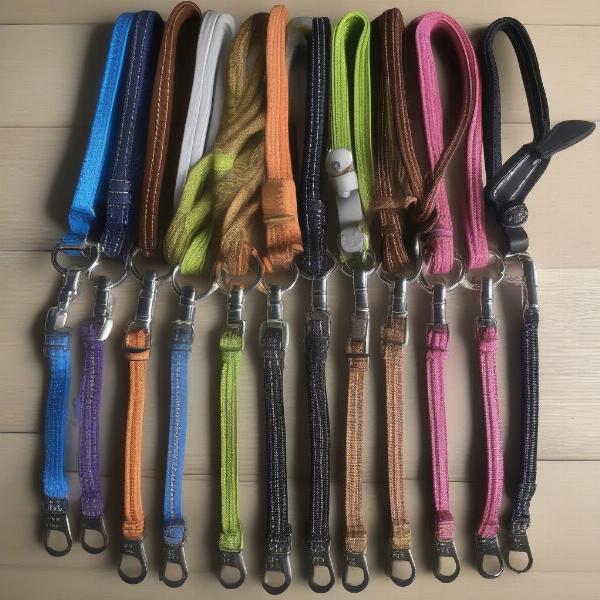A British dog lead, also known as a leash, is an essential tool for any dog owner in the UK. Choosing the correct lead ensures both the dog’s safety and the owner’s peace of mind during walks and outings. This guide explores the various types of British dog leads available, helping you select the perfect one for your furry companion. From traditional leather leads to modern retractable options, we’ll cover everything you need to know to make an informed decision.
Choosing the right lead involves considering your dog’s breed, size, age, temperament, and training level. A small, well-trained dog might thrive with a lightweight standard lead, while a larger, more energetic breed might require a sturdy, longer lead or even a specialized training lead. The environment you typically walk in also plays a role. For urban settings, a shorter lead offers better control, while longer leads are suitable for open spaces like parks or fields.
Types of British Dog Leads
Several types of dog leads cater to different needs and preferences. Understanding the pros and cons of each will help you determine the most suitable option for your dog.
Standard Leads
Standard leads are the most common type, typically made from nylon, leather, or rope. They come in various lengths and widths. Leather leads offer durability and a classic look, while nylon leads are lightweight and often come in bright colours for increased visibility.
 Standard Dog Leads in Various Materials and Colors
Standard Dog Leads in Various Materials and Colors
Retractable Leads
Retractable leads offer greater freedom for dogs to explore. They allow the dog to roam within a certain radius while still under the owner’s control. However, they require careful handling to avoid accidents and injuries.
Training Leads
Specifically designed for training, these leads often include features like adjustable lengths or integrated slip leads for better control and correction.
Slip Leads
Slip leads tighten around the dog’s neck when pulled, providing a quick and effective way to correct unwanted behaviour. However, they must be used with caution to avoid choking or injuring the dog.
Material Matters: Leather vs. Nylon vs. Rope
Each material offers unique benefits and drawbacks. Leather leads are durable and comfortable to hold but can be heavier and require more maintenance. Nylon leads are lightweight, easy to clean, and affordable, but they may not be as durable as leather. Rope leads are generally strong and offer a good grip, but they can be rough on the hands and prone to fraying.
Which Length is Best?
The ideal lead length depends on your dog’s size, temperament, and the walking environment. A shorter lead provides more control in busy areas, while a longer lead offers more freedom in open spaces.
Finding the Perfect Fit for Your Dog
Consider your dog’s specific needs when choosing a lead. For puppies, a lightweight and adjustable lead is recommended. Older dogs may benefit from a padded or ergonomic handle for added comfort. Energetic dogs might need a sturdy lead with a secure clasp.
Conclusion
Choosing the right British dog lead is crucial for enjoyable and safe walks with your furry friend. Consider your dog’s individual needs, the type of walking you do, and the different lead materials and features available to make the best choice. A well-chosen lead will not only enhance your walks but also strengthen the bond between you and your canine companion.
FAQ
- What is the best type of lead for a puppy? A lightweight, adjustable nylon lead is often recommended for puppies.
- Are retractable leads safe? Retractable leads can be safe if used responsibly, but they require careful handling to prevent accidents.
- How do I choose the right length for my dog’s lead? The ideal length depends on your dog’s size, temperament, and the walking environment. Shorter leads offer better control, while longer leads provide more freedom.
- What is the most durable material for a dog lead? Leather is generally considered the most durable material, followed by rope and then nylon.
- How do I clean a dog lead? Cleaning instructions vary depending on the material. Leather leads require specific leather cleaners, while nylon leads can often be washed with soap and water.
- What are training leads used for? Training leads are designed to assist with dog training, often featuring adjustable lengths or integrated slip leads for better control.
- Are slip leads safe for dogs? Slip leads can be safe if used correctly, but they should never be used to choke or injure the dog.
Related Articles
ILM Dog is a leading online resource for dog owners worldwide, providing expert advice on dog breeds, health, training, nutrition, grooming, and much more. We are dedicated to helping you provide the best possible care for your canine companion. Whether you are a seasoned dog owner or just starting out, ILM Dog offers valuable information and resources to support you every step of the way. From choosing the right dog breed to understanding their specific dietary needs, we’re here to help. Contact us via email at [email protected] or phone at +44 20-3965-8624 for personalized guidance.